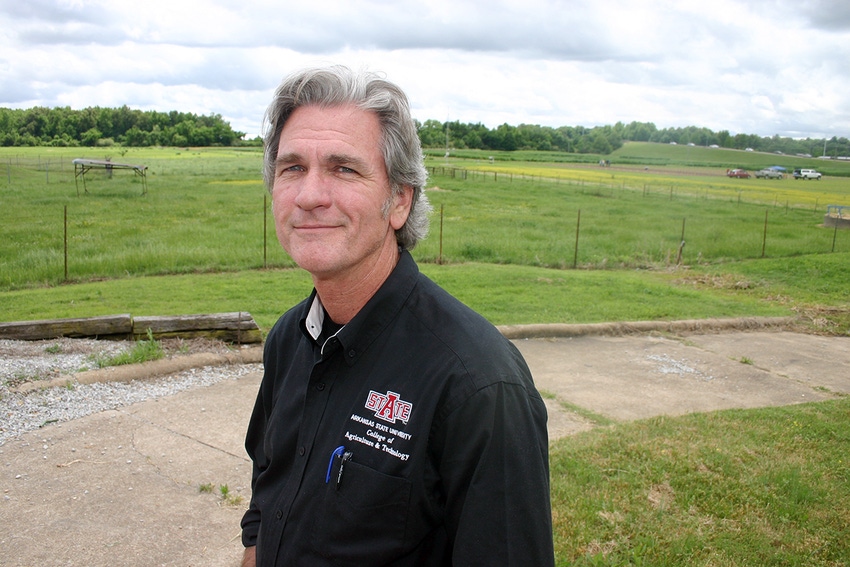
Surrounded by educational posters and a large dry board full of mathematical equations, Kevin Humphrey sits explaining how the biodiesel lab in adjacent rooms came to be.
“I’ve been here since 1993,” says the associate professor of agricultural education at Arkansas State University in Jonesboro. “We began this lab project in earnest in 2008 and finished in 2010.
“We worked with electricians and plumbers, but, since I was in construction prior to getting into education, we did all the framing, dropped ceilings and the like. We actually began making fuel in 2010.”
At first, Humphrey’s aim was to analyze biofuels, biodiesel. The problem was access to biodiesel was rather limited in the state. “So, if I was to analyze it, I had to produce it as well. One thing led to another and here we are.”
Humphrey is speaking in the lab’s office of data collection where he normally works with students. “This is for engine testing — right now we’re working with a Kubota single-cylinder diesel that allows us to test soy biodiesel or any other.”
As the lab moved into biodiesel production, the situation was further complicated with the generation of byproducts — mostly meal and glycerin. Dried distiller’s grain (DDG) is familiar to many livestock producers. That byproduct “comes from the production of ethanol, but biodiesel from oilseeds does provide meal on the back end. The meal can (also) be used for livestock feed.”
It isn’t just university students that Humphrey is attempting to reach with his work. He works with high school students in hopes they’ll understand the possibility of setting up an entrepreneurial biodiesel facility, become their own boss.
Towards that end, Humphrey has taken a lab model into classrooms across northeast Arkansas. High school chemistry, technology and agriculture teachers have also benefited from workshops he’s run showing how to incorporate a biodiesel lab in their classrooms.
How integrated is Humphrey’s work with the rest of the ASU farm?
As an example, “When soybeans are harvested from the farm, I’m provided with whatever isn’t needed from research plots. So, say I received 200 bushels from the last harvest. The facility we’ve created means it takes 80 hours to process the 200 bushels.
“I get 131.2 gallons of soybean oil and about 5.5 tons of soybean meal. Converting that to biodiesel with about a 96 percent return on the oil means about 126 gallons of biodiesel.
“That’s used on the farm and soybean meal is either provided to the farm — about 21,000 pounds at last count — or sold. We’ve sold about 9,000 pounds to those outside wanting to buy.”
With all that going on, the lab is now almost self-sustaining. “If someone wants soybean meal, canola meal, or whatever, we can generate it from the crops we grow or can obtain. That doesn’t mean I’m not working on a shoestring budget, unfortunately.”
Humphrey and students use five feed stocks: soybeans, canola, camelina, cottonseed and waste vegetable oil.
“The problem with using cottonseed is you have to remove the cellulose around the seed or it clogs up the cold presses. I haven’t been able to devise a quick, cheap way to get that cellulose off the seed. I’ve been working with cotton organizations to see if they can provide some delinted cottonseed.”
Putting together a small processing facility like this one in farm country municipalities makes sense, says Humphrey. “Look at what we can do in this small lab. Some entrepreneurs and/or farmers could put together a facility in town that would benefit so many.
“In fact, the mayor and couple of other people from DeWitt came up here to check out what we’re doing. They’re going to do something similar for the city. I’m helping them establish the biodiesel and oil-pressing capabilities.
“They’ll be able to produce something like 500 gallons of biodiesel a day. They’ll use that for the municipal and county fleet of vehicles. They’ll also incorporate waste vegetable oil and work out a system where they can do some recycling.
“It seems these smaller facilities could be set up in rural locations where the feedstocks are being grown. That means transportation costs would be lower and needed jobs could be generated. It can be done,” insists Humphrey.
“Yes, we’re after the oil, but there’s a lot of meal produced that can help defray expenses. That can be used for livestock or poultry feed — and everyone knows there are plenty of chicken houses in Arkansas.”
Other small Delta towns are watching DeWitt. “If they’re successful, that’ll spur more folks to try it.”
One of the issues, of course, is when gasoline and diesel fuel prices go down the interest in biodiesel also drops. “Crude oil prices rise and everyone says, ‘Oh, gosh, time to jump back into biodiesel.’
“I’m not an economist, but my hope is to stay even-keeled through the ups and downs and investors with long-term goals are attracted. Right now, I can make a gallon of biodiesel from waste vegetable oil for roughly $1. When diesel is $2, or higher, that looks pretty good.”
About the Author(s)
You May Also Like




